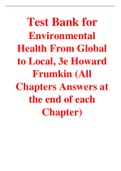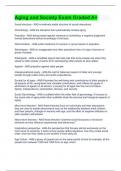Exam (elaborations)
Environmental Health From Global to Local 3rd Edition By Howard Frumkin (Test Bank)
- Course
- Institution
Environmental Health From Global to Local 3rd Edition By Howard Frumkin (Test Bank) Environmental Health From Global to Local 3e Howard Frumkin (Test Bank)
[Show more]





